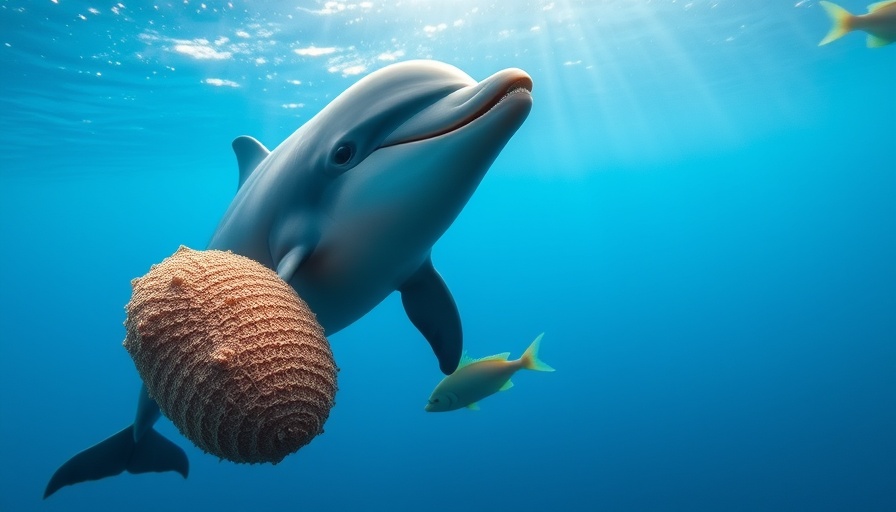
Fascinating Tool Use Among Australian Dolphins
Deep off the coast of Western Australia, bottlenose dolphins are showcasing an impressive feat of intelligence and adaptability. These dolphins have been observed using marine sponges as foraging tools—a remarkable behavior that speaks volumes about their cognitive abilities and cultural practices. By wearing sponges on their snouts, these dolphins are not only protecting themselves from the harsh seafloor but also enhancing their hunting efficiency. This method of fishing involves stirring up sand to coax out fish that typically hide beneath the sediment, demonstrating a sophisticated understanding of their environment.
Cultural Learning in the Wild: A Reflection
The sponge-using behavior among these dolphins presents a fascinating case study of culture in non-human species. Not only do dolphins learn from each other, but the skills necessary to utilize these sponges are passed down through generations. This phenomenon suggests that cultural knowledge is not exclusive to humans. With varying techniques unique to each pod, the differences illustrate the nuances in learning and the importance of social structures in animal behaviors.
The Hard Work Behind Sponge Foraging
Despite the cleverness of their tool use, hunting fish with sponges is not as straightforward as it may seem. It requires significant skill and practice, as dolphins must navigate complex underwater terrains and adjust their strategies in real-time. This foraging method has been described as labor-intensive and challenging, underscoring the point that even intelligent creatures face difficulties in their survival techniques. Dolphins are persistent learners, and this struggle benefits not just their immediate hunting outcomes but their overall adaptability.
Connecting Human Innovation and Animal Behavior
As we delve deeper into dolphin behaviors, parallels can be drawn to human creativity and innovation. Just like dolphins refining their hunting strategies, humans develop tools and techniques to overcome challenges in various environments. This connection beckons us to consider how observing animal behaviors can offer insights into our approaches to innovation. Why should we limit our understanding of problem-solving to our species alone when nature has so much to teach us?
Future Predictions for Dolphin Research
The continued study of these dolphins in Shark Bay holds promise for uncovering even more intriguing aspects of their culture and tool use. Researchers anticipate that as technology advances, we may gain deeper insights into the vocalizations and social interactions that underlie these complex behaviors. Moreover, understanding how environmental changes impact their foraging strategies may shed light on adapting animal behaviors in the face of climate change.
Community Impacts and Conservation Efforts
Conservationists are increasingly recognizing the value of understanding dolphin behavior as a means of enhancing efforts to protect marine ecosystems. By focusing on the social structures and cultural practices of dolphin pods, initiatives can be more directed towards preserving not just the species but the intricate webs of life that they support. This calls for community engagement in conservation efforts, emphasizing education about the importance of marine biodiversity.
Common Misconceptions Around Dolphin Intelligence
While dolphins are often hailed as one of the most intelligent animal species, misconceptions abound regarding what exactly this intelligence entails. Many people regard intelligence purely in terms of learning vocabulary or performing tricks, overlooking aspects like social learning and problem-solving in natural settings. The sponge-foraging behavior showcases a more nuanced dimension of intelligence—one based on environmental interaction and social cooperation.
Join the Conversation on Dolphin Behavior
The insights gained from observing these Australian dolphins have broader implications for understanding animal intelligence and cultural learning. The conversations around these topics are gaining traction on social media and trending news in the world today, inviting a wider audience to appreciate the splendor of marine life. Keep an eye on such occurrences as they unfold and participate in discussions around animal behaviors to enrich our collective understanding.
If you’re intrigued by animal intelligence and its connection to human behavior, stay tuned for more fascinating stories that highlight how our world intertwines with nature’s marvels. Don't just observe; engage and contribute to the continued discourse on these emerging insights.
 Add Row
Add Row  Add
Add 




 Add Row
Add Row  Add
Add 

Write A Comment